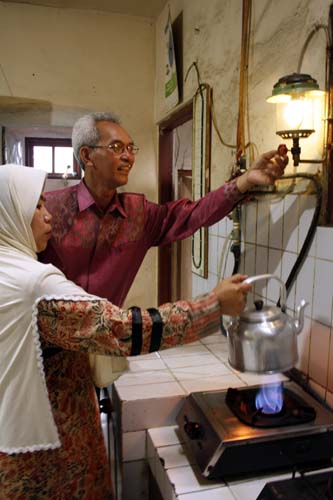
Biogas Rumah yang Murah dan Ramah
By: Musyawir
Pasuruan - Endang Hariyanto, a housewife in Gendro village, Tutur (Nongkojajar) subdistrict, Pasuruan District, lightened up after using alternative energy biogas for her cooking needs, lightings and water heater at home.
Endang also said that the using of biogas able to press daily expenses down, especially routine cost to buy kerosene or gas worth between IDR 350,000 to IDR 400,000 per month.
"But the priceless thing is the ease feeling in using biogas. It is far safer than any other gas," she said.
She stated that she no longer worried ever since she used biogas alternative energy for even though biogas can easily burn, it would not cause explosion if there should ever be a leaking.
Biogas using, as Endang further said, does not merely produce friendly environment. The digester's bio-slurry could also be used as raw material for organic fertilizer.
She also said that bio-slurry produced by biodigester at her house was used to fertilize paprika plants after fermentation process done. Bio-slurry has its good quality to be used as paprika planting medium because it decreases fertilizer using for about twenty percent.
Endang Hariyanto is one among 1,215 households using biogas alternative energy in Tutur subdistrict or more well known as Nongkojajar.
In Nongkojajar there are 17,765 milk cow breeds with potential cow dung around 20 kilograms each are used for biogas through 883 units of household scale biodigesters.
Biodigester
The Secretary of Milk Cow Farmers Cooperative (KPSP) 'Setia Kawan' in Nongkojajar, Hariyanto, who is also in charge of biogas enhancement said that until December 2012 KPSP 'Setia Kawan' in assistance for farmers have targeted 1,250 biodigester units.
He said that every biodigester unit can be utilized for at least 4 to 5 people. The making of biodigester in Nongkojajar presented in partnership with various parties such as NGO Hivos, BNI Syariah Malang, Bank Syariah Mandiri Malang, BLH Kabupaten Pasuruan, PT. Nestle Indonesia and Perhutani Pasuruan.
Bio-slurry from cow dung in large amount in Nongkojajar is utilized for organic fertilizer needed by farmers as plants fertilizer.
Among the plants are chrysanthemums, paprika, apple, sugar cane, hard wood trees seedlings, and 'Setia grass' - similar to 'rumput gajah' with small leaves and attract cows. The overflow of organic fertilizer products also influenced environment preservation and income increases of farmers.
Thus by the availability of biogas alternative energy, people do not cut hard plants for firewood which affects water sources and springs conservation needed by farmers in raising their milk cows. It has been stated that each milk cow needs about 80 to 150 liters of water a day, while almost half of 150 springs around were dry at a time.
However since there has been biogas alternative energy implementation with its effects on environment preservation, many springs in Nongkojajar that once dried are now flowing water.
Domestic Biogas Programme Provincial Coordinator for East Java Indonesia, Wasis Sasmito, said that 3,896 biodigester units have been constructed in 45 districts in East Java; among them are Trenggalek, Blitar, Batu, Mojokerto, Pasuruan, Probolinggo, and Lumajang.
Wasis Sasmito then stated that there could be at least 1 million digester units built in national scale. But in fact there are only about 10 thousands household scale biodigester built.
'There is even a chance in making biogas as new business,' said Wasis Sasmito.
In the mean time, Wasis said further, biodigester implementation is an effort to fulfill household scale energy needs. There is a significant interest on biodigester by farmers' households for its capability in decreasing life expenses.
The using of biogas as alternative energy able to decrease a family's kerosene or firewood needs until about IDR 350,000 to IDR 400,000 per month. Every 1 kilogram of cow dung processed in digester can produce around 37 liters of gas.
One digester unit could fulfill gas needs for a family of four to five members, even though every digester can be developed bigger according to its volume.
There are at least five types of biodigester in Nongkojajar; 4 meters cubic volume, 6 meters cubic, 8 meters cubic, 10 meters cubic and 12 meters cubic.
The smallest type - 4 meters cubic - needs at least two to three cows' dung, while the biggest - 12 meters cubic volume - needs six cows' dung as its basic material.
It was explained that the expenses needed to build each of the biodigester is equivalent with expenses needed for 3 kilograms gas requirements in three years. But the period of time of implemented biodigester can reach until about twenty years.
Wasis said that most farmers in Nongkojajar are working on biodigester with 6 meters cubic volume upwards. It was mentioned that the implementation of a 6 meters cubic biodigester costs IDR 6,5 million.
The size of 8 meters cubic costs IDR 7,5 million, 10 meters cubic costs IDR 9 million, while 12 meters cubic costs IDR 11,5 million. Farmers get subsidy of IDR 2 million out of total amount for each digester unit in implementing biodigester, while the rest facilitated by banking credits which is paid in long term installment by farmers.
Utilization of biodigester also decreases agriculture cultivation expenses. Bio-slurry produced by cow dung in biodigester can be used as basic material for organic fertilizer after fermentation process. It has been stated that every one thousand meters farming field needs only about one hundred liters of bio-slurry, worth IDR 125,000.
That leads domestic biogas utilization to accessible cost and eco-friendly outcomes in Indonesia.
Source: www.antarajatim.com


